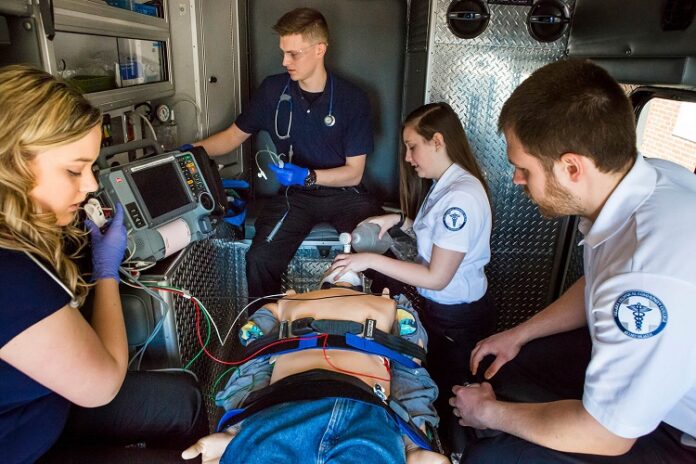Firefighters and paramedics are frontline heroes who dedicate their lives to saving others. These professionals respond to emergency calls around the clock, selflessly risking their own safety to protect and assist those in need. They also work closely with public officials to manage emergencies and disasters effectively. For more information about these brave individuals and their essential roles, visit Putflix.
Over 41,157 firefighter paramedics are employed in the U.S. The role of firefighter paramedic demands dedication, courage, and a relentless commitment to service. Becoming a paramedic firefighter will be your best bet if you want to become a first responder and serve your community.
The path to becoming a firefighter paramedic might seem difficult, but it isn’t. These tips will equip you with the knowledge you need to get a head start.
Table of Contents
#1 Get a Relevant Degree
You cannot become a firefighter paramedic unless you obtain a relevant degree.
The minimal requirement to work as a firefighter paramedic varies from state to state. But, in most states, an associate’s or a bachelor’s degree in an area such as fire sciences, paramedicine, or emergency medical services will do.
You might secure entry-level employment if you hold a high-school diploma or a GED (General Educational Development). But with a post-secondary degree, you will gain the upper hand and stand out from the pool of candidates.
You will also receive comprehensive training in firefighting techniques, emergency medical procedures, and relevant regulations and protocols. You will also be equipped with all the skills you need to succeed as a paramedic firefighter.
Post-secondary programs include courses and in-field training in fire prevention, firefighting practices, trauma management, emergency response protocols, and emergency medical treatments.
Be sure to learn about your state’s educational requirements, though. This will help you determine which course you should pursue for your career goals.
#2 Obtain Paramedic Certification
You must obtain a paramedic certification from the NREMT (National Registry of Emergency Medical Technicians) in order to work as a firefighter paramedic. Hence, get yourself enrolled in a paramedic certification program to work as a licensed first responder in your state.
This program normally takes place over a course of 6 to 12 months and ranges from 1,200 hours to 1,800 hours—50 days to 75 days.
However, you’ll likely need prior training as an emergency medical technician (EMT) and some work experience, typically at least six months. You can gain this experience through entry-level positions in firefighting or other emergency response roles.
Paramedic certification programs build upon the foundational knowledge and skills acquired during EMT training. Thus, these provide you with the advanced expertise needed to handle more complex medical situations.
Topics covered in paramedic certification programs may include physiology, anatomy, cardiology, advanced airway management, biology, and EKG interpretation.
#3 Prepare for the Hiring Process
The hiring process for a firefighter paramedic involves several stages. This includes physical agility tests, written exams, interviews, background checks, and medical evaluations.
Physical agility tests assess the physical fitness and ability of candidates to perform job-related tasks, such as carrying equipment, climbing stairs, and dragging hoses. Regular exercise will help you prepare for these tests.
Familiarize yourself with firefighting and EMS concepts, such as medical terminology, fire behavior, and emergency response protocols, through practice tests and study guides. This will help you succeed in written exams.
Also, make sure you have a clean background record. Rest assured that you will be able to navigate the hiring process smoothly and secure a firefighter paramedic position.
#4 Continue Learning
For paramedic firefighters, staying abreast of advancements in the field of firefighting is important, especially amidst ongoing developments like the AFFF lawsuit.
Aqueous film-forming foam (AFFF) has been used to douse fires in shipboard and shore facilities, fire fighting vehicles, and fire training facilities. While it’s effective in dousing fires involving flammable liquids, per- and polyfluoroalkyl substances (PFAS) in AFFF are carcinogenic. A recent study linked AFFF with testicular cancer.
Almost 7,000 AFFF foam lawsuits have been filed nationwide. TorHoerman Law explains that PFAS chemicals have been linked with a host of cancers, including bladder, breast, colon, pancreatic, liver, and kidney.
Firefighters are suing the manufacturers of AFFF in their suits. More than a dozen companies have been named in the AFFF foam lawsuit. Some of them include DuPont, 3M, Tyco Fire Products, ChemDesign Inc., Chemours, and Chemguard Inc.
As a firefighter paramedic, you must stay informed about the latest findings and regulations regarding AFFF usage to minimize exposure risks and ensure safe practices. You must also learn about alternative firefighting agents that mitigate environmental and health hazards while dousing fires effectively.
Attending workshops, seminars, and conferences and enrolling in advanced training courses will help you stay updated about the latest developments in firefighting.
To wrap things up, becoming a firefighter paramedic is a noble pursuit. All you need is dedication, perseverance, and a genuine desire to serve others. You can embark on a fulfilling career as a frontline hero by following the tips discussed here.
Bear in mind that becoming a firefighter paramedic is tough, but it’s immensely rewarding. After all, you get the opportunity to make a meaningful difference in the lives of others every day.




